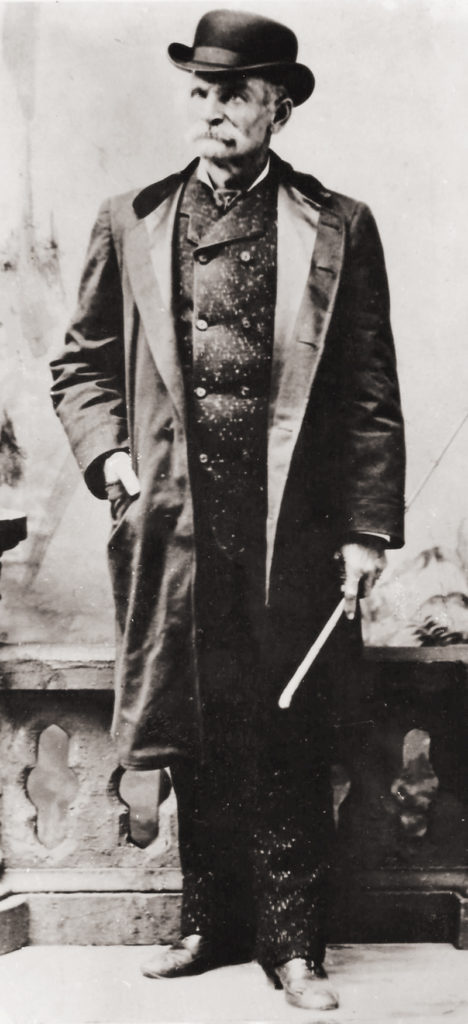On the American fronter shotguns—smoothbore firearms that could be loaded with bird shot, buckshot, lead balls or “buck and ball”—justly came to be feared at close range. Smoothbore “front stuffers” date from the 16th century when Europeans first used “fowling pieces,” mainly to hunt birds. By the early 18th century English gentry and well-heeled gamekeepers were employing muzzleloading fowling pieces. Exactly when the term “shotgun” came into common usage is uncertain, though it appears in correspondence from Fort Boonesborough, Ken., in 1776, the year after that settlement’s founding by famed frontiersman Daniel Boone. In his 1848 novel The Oak Openings; or, The Bee Hunter historical novelist James Fenimore Cooper mentions a “double-barreled ‘shot-gun’…to use the language of the West.”
Through the 1800s shotguns (aka “scatterguns”) remained popular among bird hunters. While smoothbore muskets served the same purpose, “double guns” were an improvement, as they allowed for a follow-up shot. During the American Civil War the double-barreled scattergun proved effective, not to mention imposing with those cavernous twin tubes down which an enemy might find himself staring. John Singleton Mosby, William Quantrill and other Southern guerrillas fond of hit-and-run cavalry tactics but short on military firearms found sawed-off percussion shotguns the ideal tool for inflicting damage on Yankees. One prepped a muzzle-loading shotgun by pouring gunpowder from a flask down each barrel, stuffing in paper wadding, followed by a load of buckshot, then another wad of paper tightly compressed using the ramrod that rested in twin ferrules beneath the barrels. After one placed a percussion cap on the nipple at the back of each barrel and cocked the hammers, the gun was ready to fire.
GET HISTORY’S GREATEST TALES—RIGHT IN YOUR INBOX
Subscribe to our HistoryNet Now! newsletter for the best of the past, delivered every Monday and Thursday.
In the 1870s modern breech-loading shotguns capable of firing paper-hulled cartridge loads became commercially available. While they were a huge improvement over muzzleloaders, few Americans could afford the fancy new break-action models made by such manufacturers as W.W. Greener, L.C. Smith and Parker Bros. Enterprising dealers filled the void by importing affordable Belgian-made breech-loading shotguns for the average wage earner. In no time the obsolete muzzleloaders could be purchased for a dollar or two, though only diehards and those unable to afford breechloaders were clamoring for them. The fast-loading break-action models soon had a following among lawmen and express guards (hence the expression “shotgun messengers”), not to mention the outlaws who plagued them.

Charles E. Boles (alias “Black Bart”) was the nation’s most prolific road agent, having robbed more coaches than any other bandit. Between 1875 and ’83 he held up 29 stages in northern California, always brandishing a sawed-off double-barreled shotgun—usually a cartridge breechloader, though occasionally a muzzleloader. Stepping into the road donned in a flour sack mask, he would politely order the driver, “Throw down the box.” On two occasions he left at the scene bits of droll verse signed “Black Bart.” That grabbed the attention of newspapers, which dubbed him the “Poet Highwayman.” In keeping with his gentlemanly reputation, he reportedly never fired a shot during his many robberies. To avoid suspicion when traveling, Boles carried his breechloaders broken down into their component parts—stock and barrel—and concealed within a bedroll. On those few occasions he used a muzzleloader, he did the same by first removing the flat tenon pin in the forearm that holds the barrel to the frame.
During his last holdup—on Nov. 3, 1883, on Funk Hill, a few miles southeast of Copperopolis—Bart fled with the loot, concealing it and the shotgun, after having been fired on and wounded by a young passenger. In his haste he dropped several personal items, including his handkerchief, which tireless Wells Fargo detective Henry N. “Harry” Morse used to track down Boles through a San Francisco laundry. Convicted and sent to San Quentin, Black Bart vanished soon after his 1888 release.
Over the years a string of old-timers claimed to have found the shotgun Black Bart had concealed after his last robbery. In fact, as part of a plea deal Black Bart had led Morse and two other lawmen to the loot and the shotgun, which he’d hidden in a hollow log on Funk Hill. The firearm they retrieved is likely the “Black Bart shotgun”—a 12-gauge Loomis IXL No. 15 (Serial No. 36822) with a sidehammer and sawed-off barrels—that Wells, Fargo & Co. displayed in the company’s exhibit at the 1893 World’s Columbian Exposition in Chicago. In 1918, amid World War I, Wells Fargo was absorbed by the government-run American Railway Express Co., which inherited Black Bart’s shotgun. In 1927 the vice president of the company presented the weapon to W. Parker Lyon, a wealthy collector who was assembling artifacts for his sprawling Pony Express Museum in Los Angeles County. In 1955, when the museum finally closed six years after Lyon’s death, Bill Harrah, owner of the namesake hotel and casino in Reno, Nev., bought and relocated the entire museum collection. In 1986 firearms collector Greg Martin of San Francisco purchased the collection from Harrah’s and promptly auctioned off all but three coveted firearms, including Black Bart’s scattergun. Boles’ shotgun was eventually acquired by the Autry Museum in Los Angeles, where it remains on display.
Thanks for the assistance of Wild West special contributor John Boessenecker, who is writing a biography of Black Bart.






